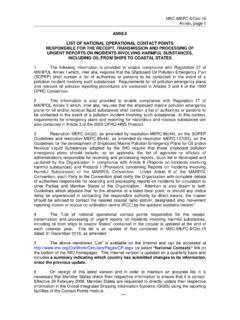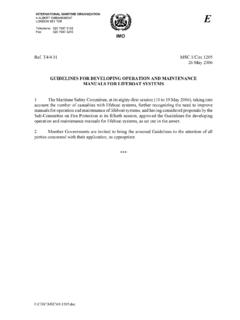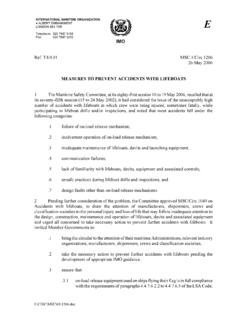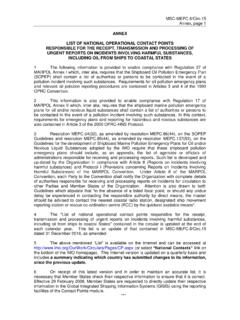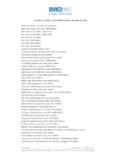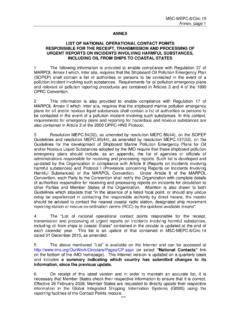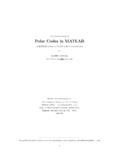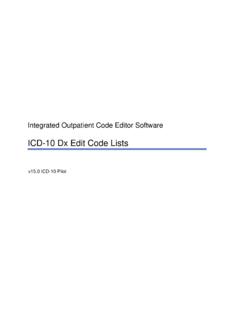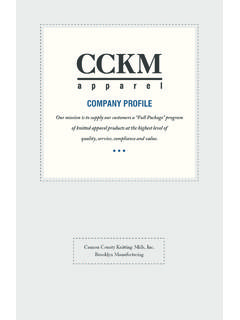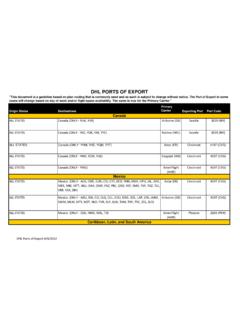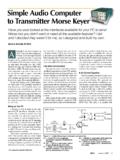Transcription of HOW THE POLAR CODE PROTECTS THE ENVIRONMENT
1 HOW THE POLAR code PROTECTS THE ENVIRONMENTTHE INTERNATIONAL code FOR SHIPS OPERATING IN POLAR WATERS WILL ENTER INTO FORCE ON 1 JANUARY 2017IT APPLIES TO SHIPS OPERATING IN ARCTIC AND ANTARCTIC WATERS: ADDITIONAL TO EXISTING MARPOL REQUIREMENTSIT PROVIDES FOR SAFE SHIP OPERATION AND PROTECTS THE ENVIRONMENT BY ADDRESSING THE UNIQUE RISKS PRESENT IN POLAR WATERS BUT NOT COVERED BY OTHER INSTRUMENTSOILCHEMICALSSEWAGEGARBAGEDISC HARGESD ischarge into the sea of oil or oily mixtures fromany ship is prohibitedSTRUCTURED ouble hull and double bottom required for all oil tankers, including those less than 5,000dwt (A/B ships constructed on or after 1 January 2017)HEAVY FUEL OILH eavy fuel oil is banned in the Antarctic (under MARPOL). Ships are encouraged not to use or carry heavy fuel oil in the ArcticLUBRICANTSC onsider using non-toxic biodegradable lubricants or water-based systems in lubricated components outside the underwater hull with direct seawater interfacesDISCHARGESD ischarge of noxious liquid substances (NLS) or mixtures containing NLS is prohibited in POLAR waters DISCHARGES INo discharge of sewage in POLAR waters allowed (except under specific circumstances) DISCHARGES II Sewage not comminuted or disinfected can be discharged at a distance of more than 12nm from any ice shelf or fast ice Comminuted and disinfected sewage can be discharged more than 3nm from any ice shelf or fast ice FAST ICE: Sea ice which forms and remains fast along the coast, where it is attached to the shore, to an ice wall, to an ice front, between shoals or grounded icebergsICE SHELF.
2 A floating ice sheet of considerable thickness showing 2 to 50m or more above sea-level, attached to the coastSHIP CATEGORIEST hree categories of ship designed to operate in POLAR waters in:A) at least medium first-year iceB) at least thin first-year iceC) open waters/ice conditions less severe than A and BDEFINITIONSPLASTICSAll disposal of plastics prohibited (under MARPOL) ANIMAL CARCASSESD ischarge of animal carcasses is prohibited FOOD WASTES IDischarge of food wastes onto the ice is prohibited FOOD WASTES IIFood wastes which have been comminuted or ground (no greater than 25mm) can be discharged only when ship is not less than 12nm from the nearest land, nearest ice shelf, or nearest fast ice CARGO RESIDUESC argo residues, cleaning agents or additives in hold washing water may only be discharged if: they are not harmful to the marine ENVIRONMENT ; both departure and destination ports are within Arctic waters; and there are no adequate reception facilities at those ports.
3 The same requirements apply to Antarctic area under MARPOL BACKGROUND INFOTREATMENT PLANTSD ischarge is permitted if ship has an approved sewage treatment plant, and discharges treated sewage as far as practicable from the nearest land, any fast ice, ice shelf, or areas of specified ice concentration INVASIVE SPECIESINVASIVE AQUATIC SPECIESM easures to be taken to minimize the risk of invasive aquatic species through ships ballast water and biofouling
